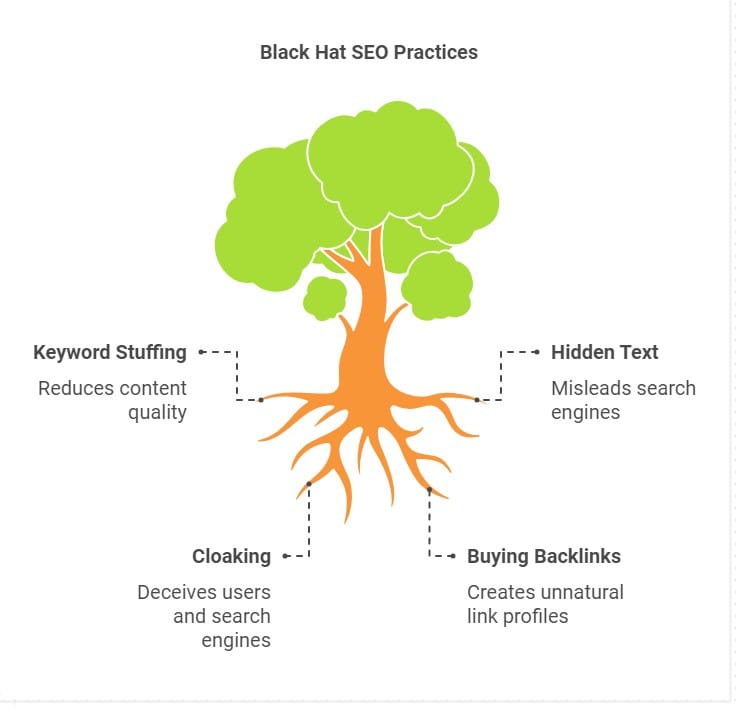Search Engine Optimization is an important process whose main aim is to make our websites in the top list search engines. Nowadays, anyone searching for something online, They firstly see the results on the first page of search engine (SERP). If you found this, you would search something like (Search Engine Optimization)
If your website appears on that page then you will get more traffic on your website which means your business will get more exposure and growth. In this article we discuss its definition, types, techniques and different approaches of SEO like “White Hat SEO” and “Black Hat SEO”. We will all discuss it.
Search Engine Optimization: Ultimate Definition & Key Insights
SEO, means Search Engine Optimization, is a proccess in which we optimize our website in search engines. Its main aim is to carry your webbsite on the top page of search engine results. If your website is optimized for search engines then it will see your website as relevant and give you higher rank to it. In this process, selection of keywords, content creation, backlinks generation and off page optimization like strategies are involved.
Before understanding SEO we will have to understand first how a search engine works. Whenever any user type query in the search engine, search engine uses an algorithm which ranks the webpages according to their relevancy. If your website is optimized and relevant, search engines will provide higher rank to any website.

We generally divide SEO in three categories.
Types of Search Engine Optimization:
1. On-Page SEO:
It implements all the techniques on the website in its contents and HTML structure. It directly focuses on webpage elements like title tags, meta descriptions, headings, URLs, content, images, and inter linking. Some common practices:
- Keyword Research: to understand the queries of your target audience and include them in your content naturally.
- Content Optimization: your content should be relevant and valuable. It is more important to write high quality and informative content.
- Title Tags and Meta descriptions: To make your Title tags and meta descriptions friendly so that they can appear in search results well.
- URL Structure: you have to make your URLs short, descriptive and keywords friendly.
- Image Optimization: you need to compress your images and give alt text so that they can optimize in search engines.

2. Off-page SEO:
It focuses on external factors of websites like backlinks, social media promotion, and mention brands. These techniques increase authority and trustworthiness of your website. Some common practices:
- Backlink Building: acquiring high-quality backlinks which can make your website more trustworthy and authoritative.
- Social Media Marketing: Share your contents on social media platforms regularly.
- Guest Blogging: this technique is very effective. In this technique you have to publish your article on other websites and create backlinks.
- Influencer Outreach: promoting your contents through industry influences.

3. Technical SEO:
This technique provides the ability to improve technical aspects of your website like website speed, mobile responsiveness, site architecture and crawlability. Some key techniques:
- Site Speed: Your website’s loading time should be fast so that you can improve your user experience and there should be no problem for search engines to crawl your site.
- Mobile Optimization: nowadays more people or active on mobile devices on browsing over there
- XML Sitemap: It helps search engines to understand your webbsite structure.
- SSL Enncryption: If your website is secured, search engines will give preferencess to your website.

White Hat SEO v/s Black Hat SEO
SEO techniques broadly divided in two categories. White Hat SEO and Black hat SEO. Both approaches and methods are very different.
1. White Hat SEO:
White Hat SEO is a technique which is performed according to the guidelines of search engines. This method helps in giving long-term and sustainable resullts. Its main focus is to provide high quality content and user experience.
Some examples of White Hat Search Engine Optimization:
- High Quality content creation.
- Relevant and ethical backlinks building.
- On-page optimization using proper keywords.
- Website speed and mobile optimization.
- User-friendlly website navigation.
The main benefit of White Hat SEO is, it works for long-term success and it avoids being penalized from search engines. If you are doing ethical SEO, your website will rank conssistently.

2. Black Hat SEO:
It is a technique which is against search engine guidelines. This method is for short-term results but it has great risk. If your website is recognnized, then your website can be penallized and de-indexed by search engines.
Some examples of Black Hat Search Engine Optimization:
- Keyword Stuffing (over use of keywords in the content)
- Hidden text or links (text that is not visible to users but to search engines)
- Cloaking (Showing different content to search engines and users)
- Buying backlinks (unnatural backlinking)
You can rank your website using Black Hat SEO for a short-term but it is risk-based because if google finds out your technique, it will penalize your site.

3. Grey Hat SEO:
Gray Hat SEO is an area between White Hat and Black Hat SEO. These are techniques which are not ethical, but also do not cause direct violations. These methods are riskier and do not guarantee long-term success.
6 SEO Tips to Boost your Website’s Ranking
If you want to implement SEO techniques and boost your website’s ranking then you will have to follow some key strategies which will help you to provide organic traffic and better ranking.
Some SEO techniques:
- Keyword Research:
Keywords are the backbone of content. If you have selected correct and relevant keywords, you will rank in search engines results soon. There are tools like Keyword Planner, SEMrush, or Aherf that can help you to find the best keywords.
- Content Quality:
Content is King! If your contents are valuable, informative, and user friendly then search engines will rank your website. You should focus on creating original content which can resolve your users’ problems.
- Backlinking Building:
Quality backlinks boost your website’s authority. We can get backlinks from Guest posting, influencer outreach, and broken link building.
- Mobile Optimization:
Mobile-friendlliness has become an important ranking factor. Nowadays, more people do browsing on mobile devices. That’s why it is more important to make your webbsite mobile-friendly and more responsive.
- Page Speed Optimization:
The loading time of your webbsite should be faster because if your website is slower then search engines will not give preeference to your webbsite. There is a tool named Google PageSpeed Insights that can help you analyze and improve your site’s speed.
- Local SEO:
If your business is local, you can also reach your potential customers by applying local SEO techniques. Creating Google My Business profile and local keywords are included in this technique.

Essential SEO Benefits to Boost Your Online Success
Businesses, bloggers, and entrepreneurs, especially in the digital era, depend on establishing an online presence. Still, a website is insufficient. Your website must score highly on search engines like Google if you want to stand out in the packed online market. Here is where Search Engine Optimization (SEO) finds application.
Key SEO Advantages for Online Success
- Enhanced Website Visits
The boost in natural traffic resulting from SEO is among its most important advantages. More visitors are likely to visit your website if it shows better on search engine results pages (SERPs). Depending on the objectives of your website, this results in more possible consumers, members, or readers. - Affordable Marketing Strategies
Search Engine Optimization is a more reasonably priced tactic than sponsored advertising. The long-term advantages exceed the initial expenses even if tool, content, and expert service investments could call for. Since organic traffic does not call for continuous ad spending, SEO is a sustainable marketing tool. - Enhanced User Journey
SEO addresses improving the user experience in addition to keywords. An optimally tuned website runs fast, is mobile-friendly, and provides simple navigation. These elements raise user happiness, lower bounce rates, and inspire guests to stay on your website longer. - Enhanced Conversion Rates
Your website draws visitors already interested in your goods or services when it ranks well for pertinent search terms. This deliberate traffic raises the possibility of turning guests into leads, subscribers, or paying consumers. - Brand Credibility and Trust
Top of search result websites are sometimes seen as more reliable and trustworthy. By means of great content, backlinks, and positive user engagement, Search Engine Optimization aids in building the authority of your brand. With time, this strengthens the trust and reputation of your brand in your area. - Long-Term Outcomes
Search Engine Optimization produces long-lasting effects unlike paid advertising, which stops creating visitors as you stop spending money. A well-optimized website offers a great return on investment since it can draw natural traffic for months or even years. - Advantage in Competitiveness
You are lost on great possibilities if your rivals are using SEO successfully while you are not. Investing in Search Engine Optimization will help you to keep ahead of the competition, grab market share, and control your niche.
Conclusion:
Search Engine Optimization is a dynamic and evolving field. If you optimize your website for search engines then you can get a website at higher rank. Which brings more traffic and conversation. White Hat SEO is an ethical and sustainable approach which provides long-term and success and guarantee whereas Black Hat SEO provides short-term benefits but there is high risk. By implementing CO techniques, you can bring your website to the top of search engine results and improve your online presence.
What is Search Engine Optimization (SEO)?
SEO is the process of optimizing a website to improve its visibility in organic (non-paid) search engine results. It involves techniques like keyword research, content optimization, and technical improvements to rank higher on Google, Bing, and other search engines.
What Are the 4 Types of SEO?
The four main types of SEO are:
On-Page SEO: Optimizing content, meta tags, headings, and URLs.
Off-Page SEO: It helps to building backlinks of your website, enhancing social signals, and brand mentions.
Technical SEO: Improving site speed, mobile-friendliness, and crawlability.
Local SEO: Enhancing visibility for location-based searches (e.g., Google My Business).
Why is SEO Important?
SEO helps:
✅ Increase organic traffic without paid ads.
✅ Improve user experience (fast loading, mobile-friendly).
✅ Build credibility & trust with higher rankings.
✅ Generate long-term results compared to paid ads.
Which Tool is Best for SEO?
Popular SEO tools (compliant with Google policies) include:
Rank Math (WordPress SEO plugin)
Google Search Console (Free, official Google tool)
Ahrefs/SEMrush (Backlink & keyword research)
Yoast SEO (Alternative to Rank Math)
Google Analytics (Traffic & behavior tracking)
What Are Backlinks in SEO?
A backlink (or inbound link) is a hyperlink from an external website pointing to your site. In SEO, backlinks act like digital endorsements—they signal to search engines that your content is valuable and trustworthy.
Why Do Backlinks Matter?
Improves Rankings: High-quality backlinks boost your site’s authority (Domain Rating/DA).
Drives Referral Traffic: Users may click through from linking sites.
Builds Credibility: Links from reputable sources (e.g., Forbes, Wikipedia) carry more weight.
What Makes a Good Backlink?
✅ Relevant: Comes from a site in your niche.
✅ Authoritative: From high-domain-authority websites.
✅ Natural: Earned organically (not bought or spammed).











One thought on “Search Engine Optimization”